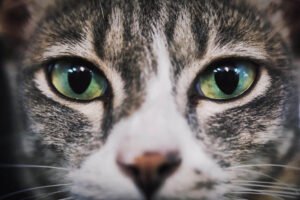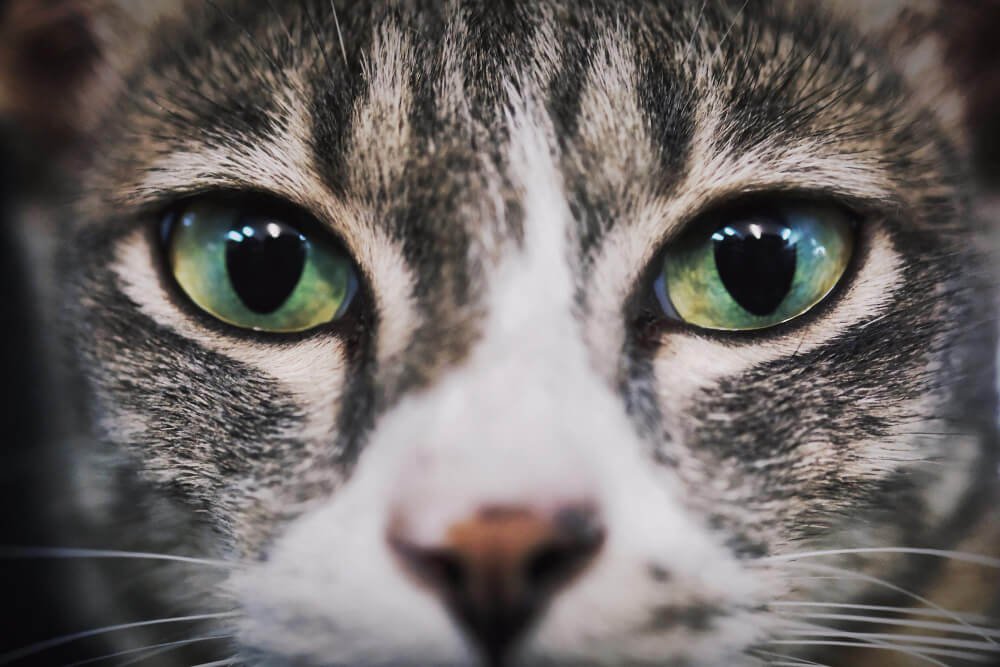Cats’ vision is tailored to their needs as agile hunters and independent explorers. Unlike humans, who rely on detail and color for daily tasks, cats need night vision, motion detection, and a keen awareness of their surroundings. These features make their vision complex, effective, and essential to their way of life. In this article, we’ll dive into how cats see the world, covering the anatomy of their eyes, their limited color perception, and their unique sensitivity to movement.
1. The Anatomy of a Cat’s Eye: Built for Survival

A cat’s eye is designed to help it hunt, detect movement, and thrive in low light. Here’s a closer look at the features that set feline vision apart:
- Large Corneas and Pupils: Cats have proportionally large eyes, which allows them to gather more light. Their pupils, which can open widely in low light, expand to let in even the faintest light. This enables cats to navigate in low-light environments and stay active during dawn or dusk.
- Tapetum Lucidum: Behind the retina lies the tapetum lucidum, a reflective layer unique to many nocturnal animals, including cats. The tapetum bounces light back through the retina, enhancing their ability to see in dim light. This layer also creates that mysterious glow when a light shines on a cat’s eyes in the dark.
- Rods and Cones: Cats’ retinas have a high number of rods—cells that help detect light and movement. They also have fewer cones, which are the cells responsible for color and detail. This rod-heavy retina enables cats to see well in low light, but it limits their color perception and clarity of details.
2. Low-Light Vision: Do Cats See in Complete Darkness?

Many people think cats can see in complete darkness. This isn’t true, but their night vision is exceptional. Cats need only about one-sixth of the light humans require to see. Thanks to their rod-dominant retinas and the tapetum lucidum, cats can see well in low-light conditions like dusk and dawn, which are the times cats are naturally most active. Their pupils dilate almost entirely in low light, maximizing the light that enters their eyes.
This low-light vision gives cats a huge advantage as hunters. They can detect movement, navigate their environment, and spot potential prey in conditions where human sight fails. While cats can’t see in total darkness, they can move comfortably with minimal light.
3. Color Perception: Which Colors Can Cats See?

Although cats don’t see the world in black and white, their color range is limited. Cats have only two types of cones (humans have three), which restricts their color perception. Scientists believe cats can see shades of blue, gray, and maybe yellow. Red, orange, and pink likely appear as grayish or muted hues.
Cats don’t need a full-color spectrum to hunt and survive. Their eyesight is focused on detecting movement, shadows, and shapes rather than vivid colors. In fact, their lack of color perception may even help them spot movement more clearly, as they are less distracted by bright colors.
4. Field of Vision: A Broader View of the World
Cats’ eyes are positioned to give them a wider field of vision than humans. While humans have a field of vision around 180 degrees, cats’ field of vision reaches about 200 degrees. This wider range allows cats to see more of their surroundings at once, which is crucial for detecting threats or prey.
Cats also have binocular vision, which means their eyes face forward and allow for an overlapping field of view. This overlap creates depth perception, which helps cats judge distances when jumping, climbing, or pouncing on prey. They rely on this depth perception when hunting or playing, which explains their precision and coordination.
However, cats’ overall vision isn’t as sharp as ours. While humans usually have “20/20” vision, cats’ vision is closer to “20/100.” Objects that a human can see clearly at 100 feet appear blurry to a cat. Cats rely on their other senses for close-up tasks, as their vision becomes less clear at short distances.
5. Motion Sensitivity: The Predator’s Advantage
A cat’s vision is tuned to detect motion, even when it’s subtle. Cats prioritize movement over color and detail, which makes them highly responsive to even the smallest changes in their surroundings. This ability comes from their large number of rod cells, which respond more quickly to motion than cone cells do.
In the wild, this sensitivity helps cats detect the slightest flicker of movement, even in low light. Domesticated cats retain this instinct, which explains their fascination with moving toys, flickering lights, and quick shadows. Cats are far more likely to focus on something moving, like a bug or a dangling string, than a stationary object.
6. Depth Perception: Cats’ Ability to Judge Distance

Depth perception is essential for animals that jump, pounce, or climb, and cats have excellent depth perception up close. Their binocular vision allows them to judge distance and depth, giving them the precision they need to time their jumps and attacks.
However, cats’ depth perception is most effective within a short range. For distant objects, cats may rely on their other senses, like hearing or scent, to understand what’s around them. This close-range focus explains why cats often carefully inspect things up close and sometimes miss objects at a distance.
7. UV Light Sensitivity: Seeing What We Can’t
Recent research suggests cats may see ultraviolet (UV) light. UV light, invisible to humans, could allow cats to perceive markings or subtle traces left by other animals. Cats might also use UV light sensitivity to track prey or detect small movements that are invisible to humans.
This UV sensitivity adds another layer to their perception and may explain why cats seem to stare at things we can’t see. They’re likely picking up traces or movements only detectable with UV light, giving them an added tool for navigating their environment.
8. How Cats’ Vision Shapes Their Behavior
Understanding a cat’s vision helps explain some of their unique behaviors. Here’s a look at how their sight influences the way they interact with their environment:
Ignoring Stationary Objects:
Cats often ignore objects that aren’t moving. They’re naturally wired to notice movement, so a still object might blend into their surroundings.
Nighttime Activity:
Cats are crepuscular, meaning they’re most active at dawn and dusk. Their low-light vision gives them an advantage during these times, which are also when many prey animals are active.
Fascination with Moving Objects:
Cats are highly sensitive to motion, which is why they love toys that mimic prey behavior. Flickering lights, darting bugs, and moving toys catch their attention instantly.
Close-Up Investigations:
Cats’ vision isn’t sharp at close distances, so they rely on other senses, like smell and touch, when examining objects up close. This is why they often sniff or bat at things they find interesting.
9. How Cats’ Vision Differs from Human Vision
Understanding the differences between human and cat vision helps clarify how each species experiences the world. Here’s a comparison of the two:
Field of Vision:
Cats have a wider field of view than humans, which helps them monitor more of their surroundings at once.
Low-Light Vision:
Cats see in conditions that would be nearly pitch black to us. Their night vision, combined with the tapetum lucidum, gives them a powerful edge in low light.
Color Perception:
Humans see a full spectrum of colors thanks to our trichromatic vision, while cats see a limited range of blue, gray, and yellow.
Motion Sensitivity:
Cats are highly responsive to motion, which is crucial for hunting. They often detect movements that are invisible to human eyes.
10. A Cat’s Unique View of the World

Cats’ view of the world is subtle, focusing more on shape, movement, and shadows than bright colors and fine detail. Here’s a recap of their distinctive vision:
Superior Night Vision:
Cats’ specialized retinas and the tapetum lucidum allow them to see with very little light.
Limited Color Range:
Cats mostly perceive shades of blue, gray, and yellow, while reds and oranges appear muted.
Movement Sensitivity:
Cats prioritize motion over detail, making them highly responsive to quick shifts in their environment.
Wide Field of Vision:
Their broader field of view helps them scan more of their surroundings at once.
Potential UV Sensitivity:
Cats may see ultraviolet light, adding another layer to their perception.
How Understanding Cat Vision Can Improve Your Bond with Your Cat

Knowing how cats see helps us better understand their preferences and habits. Here are some ways this knowledge can improve your bond with your cat:
Choose the Right Toys:
Because cats are drawn to movement, toys that mimic prey (like feathers or toys on strings) are highly engaging. Avoid bright colors and focus on toys with lifelike motions. See Also The Science of Cat Toys: Which Toys Keep Cats Engaged the Longest?
Respect Their Space:
Cats don’t always see close objects clearly. Give them space when they’re exploring new things, and let them sniff or bat objects to investigate.
Provide Nighttime Comfort:
Cats’ low-light vision helps them navigate in dim light, but they may appreciate soft lighting in areas where they sleep or explore at night. I use L LOHAS LED Night Light Plug ins , they are perfect and look nice too!
Create Safe Exploration Zones:
Cats have a wide field of vision but prefer to stay within close range of familiar areas. Give them cozy spaces where they feel safe but can still monitor their surroundings.
Engage Their Curiosity with Moving Objects:
Cats are more likely to notice moving objects than stationary ones. Use toys or light projections that move to stimulate their natural curiosity.
Conclusion: Appreciating Cats’ Unique View of the World

Cats see the world differently from us, experiencing a landscape of shadows, movement, and soft colors. Their vision is built for survival, allowing them to hunt, explore, and respond to changes in their environment. Understanding their unique view helps us appreciate their instincts and behaviors.
While their perception may lack the color and detail we’re used to, it’s rich in its own way, perfectly suited to the needs of a curious, skilled hunter. With this insight, we can better understand our feline friends and foster a stronger bond through respect for their special way of seeing the world.

